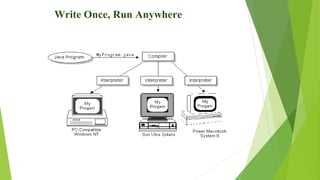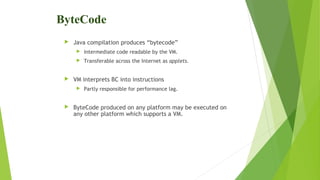Introduction to Java
- 2. Introduction to Java J ava is an object oriented programming language.. A Java Virtual Machine (JVM) is used to run Java programs.The JVM can be made to run on different platforms, like Linux and Windows, so the same Java programs can run on computers with different operating systems. Write Once, Run Anywhere. The Java Application Programming Interfaces (APIs, or class libraries) are a set of prebuilt classes that you can use in your own programs. if the Java language is like a set of grammar rules in a spoken language, then the APIs are dictionaries full of words that can be
- 3. Java is a general purpose, HLL developed by Sun MicroSystem The Java programming language was developed by a small team of engineers, known as the Green Team, who initiated the language in 1991. The Java language was originally called OAK, and at the time it was designed for handheld devices and set-top boxes. Oak was unsuccessful and in 1995 Sun changed the name to Java and modified the language to take advantage of the burgeoning World Wide Web. Later, in 2009, Oracle Corporation acquired Sun Microsystems and took ownership of two key Sun software assets: Java and Solaris.
- 4. Advantage Relatively Simple to Use J ava is a high level language, which means Java abstracts away (i.e. handles for you) most of the complex details of the machine (computer) such as memory management, etc. Scalability Easier to Maintain Java is a statically-typed language, which means your code will have to be checked for errors before it can be built into an app As a statically typed language, Java is faster than dynamically typed languages because things are more clearly defined. Optimized Performance
- 5. Features of Java Simple Architecture-neutral Object-Oriented Distributed Compiled Interpreted Statically Typed Multi-Threaded Garbage Collected Portable High-Performance Robust Secure Extensible Well-Understood
- 6. Java is not a purely Object-Oriented Language? It fails to support: 1. All predefined types are objects 2.All operations performed on objects must be only through methods exposed at the objects. In Java, we have predefined types as non-objects The static keyword:When we declares a class as static then it can be used without the use of an object in Java.
- 7. JVM (Java Virtual Machine) JVM (Java Virtual Machine) is an abstract machine. It is a specification that provides runtime environment in which java bytecode can be executed. A specification where working of Java Virtual Machine is specified. But implementation provider is independent to choose the algorithm. Its implementation has been provided by Sun and other companies. An implementation Its implementation is known as JRE (Java Runtime Environment). Runtime Instance Whenever you write java command on the command prompt to run the java class, an instance of JVM is created
- 8. JVM (Java Virtual Machine) What it does The JVM performs following operation: 1..Loads code 2.Verifies code 3.Executes code 4.Provides runtime environment JVM provides definition for 1. Memory area 2.Class file format 3.Register set 4.Garbage-collected heap
- 9. JVM (Java Virtual Machine)
- 10. 1) Classloader Classloader is a subsystem of JVM that is used to load class files. 2) Class(Method) Area Class(Method) Area stores per-class structures such as the runtime constant pool, field and method data, the code for methods. 3) Heap It is the runtime data area in which objects are allocated. 4) Stack It holds local variables & partial results. Each thread has a
- 11. 5) Program Counter Register PC (program counter) register. It contains the address of the Java virtual machine instruction currently being executed. 6) Native Method Stack It contains all the native methods used in the application. 7) Executive Engine a. Virtual processor b. Interpreter-Read bytecode stream then execute the instructions c. Just-In-Time Compiler-compiles parts of the byte code that have similar functionality at the same time, and hence reduces the amount of time needed for compilation.
- 14. Write Once, Run Anywhere
- 15. ByteCode Java compilation produces “bytecode” Intermediate code readable by the VM. Transferable across the Internet as applets. VM interprets BC into instructions Partly responsible for performance lag. ByteCode produced on any platform may be executed on any other platform which supports a VM.















